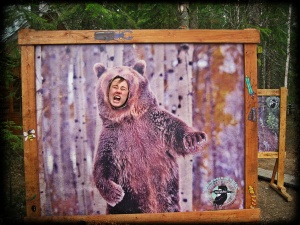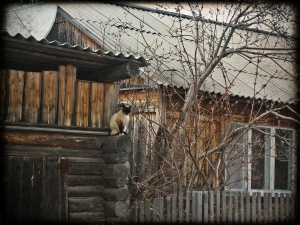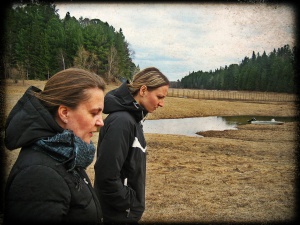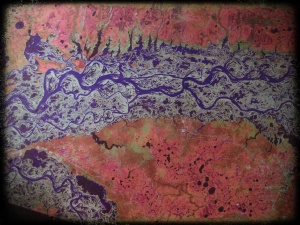Now onto Shapsha, a small village that contains a scientific research facility owned and maintained by Yugra State University. May 1st, 2012

Inside. Hana (Czech Republic), Julia (Germany) and I talk to Ilya, from Khanty-Mansiysk, who both lives and works at the facility.

Rather gloomy conditions for champagne, don’t you think? Eah, at least someone has something to celebrate…!?

The gaudy fake flowers, candy wrappers, vodka bottles and shot glasses made for a very unusual cemetery mood.

There is a zoo in Shapsha complete with 3 bears in cages the size of clown cars. There are also some ponies with gnarled manes and crusty fur and pigs who wish they could just be bacon already. I believe this bear was the jolliest living thing there.
Hana, Julia and I all went to Shapsha, a very small village about 45 minutes outside of Khanty-Mansiysk where Yugra State University has an ecological research complex, for the day. We drank endless tea and enjoyed some tasty baked goods at the research center. Ilya, one of the scientists/researchers living out there, enlightened us about everything – from clearing up the mystery behind all the lemmings (they aren’t lemmings, but rather water rats, and their presence is not the sign of an apocalyptic flood, as predicted by the “local shaman,” but rather the opposite, a three-year long dry spell that has allowed them to reproduce faster and with fewer losses) to discussing why our two rivers, the Ob’ and Irtysh, are different colors (the Irysh is clearer while the Ob’, as it runs through swamplands, is darker). We also discussed the academic and research community, both specifically in the Khanty-Mansiysk territory as well as in all of Russia. This community, he says, is having trouble lately. The earlier generation of academicians, who had pushed scientific boundaries in their time, is now too old to keep up with quickly changing research and information sharing practices. Current students are distracted and uninspired. Middle-aged scientists are losing steam waiting years for their research to be published in journals that suffer from miniscule readership, their frustration mounting. Additionally, the community suffers from a lack of funding. At Yugra State, teachers are not paid to do research, only to teach, and even that salary is minimal; thus, they have to spend most of their time teaching to earn money. Yet, despite all this, Ilya is still hopeful. He notes that these days, teachers’ salaries are substantially higher than they used to be, and there are a lot of initiatives popping up to collect data and do research on one’s own, in small groups not connected with any state projects. He says those are bringing people’s hopes up and enthusiasm for their work back.
We walked around the village, near the river, which was thinner than usual for this time of year, they said. It snowed a bit. We walked across what we assumed was the foundation to a bridge, but had been abandoned either out of funds or just interest a while back. Across the metal bridge skeleton was a hypnotic graveyard, full of florescent, hyper-optimistic plastic flowers juxtaposed onto cold, marble gravestones, so characteristic of Russian graveyards. It’s certainly a jarring contrast at the start, but there’s a sweet sincerity emanating from each waxy petal. We were caught off guard by the number of scattered vodka bottles and toppled glasses and empty candy wrappers. “Who has a party in a graveyard?!” Hana puzzled. Eventually, we came to the conclusion that they were offerings to the deceased; just as you never come empty-handed to a friend’s house, you don’t come empty-handed to visit your deceased loved ones. Whether this stems from a superstition, tradition, or true belief in an afterlife, we were uncertain. Our suspicions were confirmed when we returned to Ilya for a second round of tea and baked goods. He elaborated not only on this tradition, but also on Tatar, Gypsy, Kazakh, and Khanty burial procedures. (Tatar – not a cross before the grave, but a tall wooden post, Gypsy – a large, rectangular construction, Kazakh – perhaps a pyramid or other shape, Khanty – their dead are buried in a box, a sort of container, above ground, and often separate from the village).
Here are three overhead views of the Yugra territory.
In this shot, indigo blue is water, light blue is swamp area, and I think pink/orange is taiga region. Khanty-Mansiysk is nestled in one of those little hump-sized river pockets from that central river.
Dark brown is water, tan is swamp, aqua is forest?
A further-away view. Here, I think dark brown is burnt forest, orange is forest, and blue is water.
On the way back, Hana reminded us of two of Valera’s beloved jokes:
1) Who does a bad Russian become when he is reborn in the afterlife?
A Russian.
2) “Один – сломал, второй – потерял.” Three men are captured by a very cruel bunch of cannibals: a German, a Frenchman, and a Russian. The cannibals are brutal, but they could use some entertainment. They give the captives two iron balls and explain that if the prisoners can succeed in entertaining their captors, they will be released. The German does some sort of juggling act, the Frenchman does a magic trick, but when the captors arrive to the Russian’s cell, the balls are no where to be seen. “Well? Where are the balls? What are you going to perform for us?”
The Russian just shrugs indifferently. «Ну, один сломался, второй потерялся.» “Well, one broke, and the other got lost.”

















Wow, thanks for sharing this! It’s always nice to read about the hidden sides of Russia. Where did you get the ariel photographs? They’re satellite pictures or just taken from a plane? The first one looks really cool, cool enough to frame and hang on a wall somewhere.
Hey! I’m pretty sure the photos were originally taken from a helicopter. They’re hanging up in the research center and I just took a picture of them. Yeah, I think they look awesome, too!
Great blog you’ve got there, too! Exploring the Ukraine, nice!